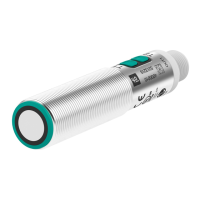UC***-18GS series
Synchronizing Multiple Sensors
2020-11
63
9 Synchronizing Multiple Sensors
The sensor is fitted with a synchronization connector that suppresses mutual interference from
external ultrasonic signals. The following 3 types of synchronization can be set:
• Automatic multiplex mode
• Automatic common mode
• External synchronization
Automatic Multiplex Mode
Several sensors (see datasheet for the maximum number) can be synchronized by simply con-
necting the synchronization connectors on the sensors. In this case, the sensors self-synchro-
nize in succession in multiplex mode.
Only one sensor sends signals at any one time. The measuring cycles of the individual sensors
run in succession in a chronological sequence. This also increases the response time of the
sensors in proportion to the number of sensors in the synchronization group.
Automatic Common Mode
Multiple sensors (see datasheet for the maximum number) can be synchronized by simply con-
necting the synchronization connectors on the sensors and setting the synchronization mode
to "Automatic common mode" via the IO-Link interface. In this case, the sensors self-synchro-
nize at the same time, i.e., all sensors always send their ultrasound pulse at the same time.
External Synchronization
Multiple sensors can be jointly controlled by an external square-wave signal, e.g., a PLC out-
put. The maximum number depends on the driver capabilities of the external device to be used
for synchronization. In this case, the sensors are triggered in parallel and operate synchro-
nously, i.e., at the same time. All sensors must be configured via the IO-Link interface in the
"External synchronization" synchronization mode.
The necessary minimum pulse duration must be observed (see datasheet). If a high level is
present on the synchronization connection for longer than 1 second, the sensor goes into
standby mode (green LED is flashing).
As long as a low level is present on the synchronization input, the sensor carries out measure-
ments in accordance with the sensor cycle time. If a high level is present on the synchronization
input for longer than 1 second, the sensor goes on standby (green LED is flashing). As long as
the sensor is in standby mode, the last received output conditions are retained.
The synchronization connection of the sensors supplies an output current in the case of a low
signal, and generates an input impedance in the case of a high signal. Please note that the
device used for external synchronization must have the following driver capability:
• Driver current acc +UB > n x (high level/input impedance)
• Driver current acc 0V > n x output current
(n = number of sensors to be synchronized)
Note
If the synchronization option is not used, the synchronization connection must be connected to
ground (0 V).
In the event that a sensor operated in a synchronized group is programmed using the
programming button, the start of the programming process may be delayed. The remaining
sensors in the synchronized group go into standby mode for the duration of the programming
process and do not carry out any measurements.
Programming of a single sensor must not be carried out using the programming button in an
externally synchronized sensor group. The remaining sensors in the group carry out further
measurements using the external trigger. This influences the measurement of the sensor to be
programmed

